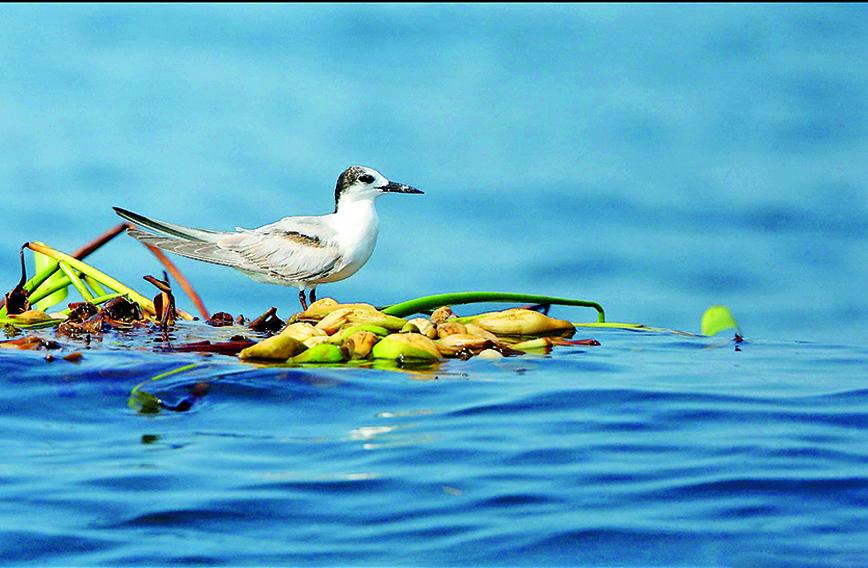
Common Tern
Birdwatchers raise red flags in massive 3-year report
Prashun Bhaumik, New Delhi
THE common sparrow and the house crow were a part of the cityscape not so long ago but are hard to come by today. Apart from pigeons, one can hardly spot any bird species in most cities. Wonder why? The State of India’s Birds 2023 is a landmark report, recently released, that takes an extensive and exhaustive look at 942 species of birds and why most are in decline, some even faced with extinction.
The report is the result of a mammoth study undertaken in partnership with 13 premier institutions — six governmental and seven NGOs — and help from a large number of independent experts. Coming after three years (the first report was in 2020), this second edition has expanded its information base with contributions from more than 30,000 birdwatchers across the country and about 30 million field observations. In 2020, the report evaluated 867 species with the number going up to 942 of India’s 1,200 bird species in the current report.
The report spells out that while there have been a few gains, it’s the losses that are of great concern. In India, generalist species like the feral Rock Pigeon, Ashy Prinia, Asian Koel and Indian Peafowl are doing very well. Other common species like the Baya Weaver and Pied Bushchat are relatively stable. But the larger picture is grim: 60 percent of species show a long-term decline and 40 percent are declining currently.
A total of 178 species have been categorized as High Conservation Priority by the report. Of these, 94 species, including the Great White Pelican, Greater Flamingo and Indian Vulture, made the list based on both abundance trends and range. Another 45, including the White-bellied Heron, Brown-winged Kingfisher and Baer’s Pochard, are very restricted. The last 39, including the Great Indian Bustard, Lesser Florican and Bengal Florican, were included based on a combination of their range and the IUCN Red List status.
 |
|
White-bellied Blue Flycatcher |
The International Union for Conservation of Nature or IUCN Red List is a critical indicator of the health of the world’s biodiversity. It is a powerful tool to inform conservation action and policy. It provides information about species’ range, population size, habitat and ecology, use and trade, threats, and conservation actions that help inform conservation decisions. The Red List Index shows trends in overall extinction risk for species. Governments use the Index to track their progress towards targets for reducing biodiversity loss.
India has diverse natural habitats for birds—from tropical rainforests with hornbills and trogons to grasslands with bustards and floricans, to deserts, mangroves and rocky hills. The decline of grasslands is especially worrisome for birds.
Some ‘specialists’ are restricted to a narrow habitat, but many other birds have adapted to a wide variety of habitats created and shaped by humans, such as plantations, agricultural fields, open fallow land, and even urban areas.
The Yellow-wattled Lapwing is an example that can live in a wide variety of ‘open’ habitats including agricultural and fallow land, lawns, and natural grassland. But the Indian Courser is more specialized and can live only in lightly grazed grasslands and adjacent fallow lands. Similarly, the White-bellied Woodpecker requires large trees, mostly found in the old-growth forests of the Western Ghats, but the Greater Flameback can survive even in old plantations.
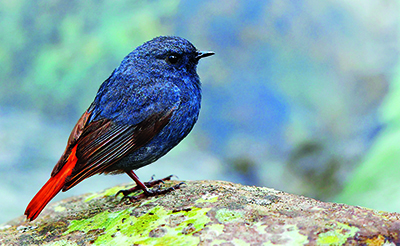 |
|
Plumbeous Redstart |
The report has found that birds that can live in multiple habitats are doing well as a group and may require less conservation. Specialists, however, are more threatened. Grassland specialists have declined by more than 50 percent. Birds that are woodland specialists (forests or plantations) have also declined more than generalists, indicating a need to conserve natural forest habitats. Birds that specialize in any ecosystem (natural or human-made) have suffered steeper declines than those that can live in multiple ecosystems.
It also observes that birds that live in open habitats are acutely impacted. Open habitats in India have been severely compromised by the spread of invasive, drought-tolerant woody plants, as well as wind turbines and power lines. Of particular note is the Great Grey Shrike, which has suffered a worrisome long-term decline of more than 80 percent. The Rufous-tailed Lark and Common Kestrel are now categorized as species of High Priority. There are exceptions, though. Adaptable birds such as the Yellow-billed Babbler and Jerdon’s Bushlark are doing well.
It also points out that the Indian vulture population’s decline has been catastrophic. This is almost entirely attributable to inadvertent poisoning by anti-inflammatory drug diclofenac being administered to livestock. Surveys conducted by the Bombay Natural History Society (BNHS) and the Royal Society for the Protection of Birds (RSPB) show that the White-rumped Vulture has suffered the most, followed by the Indian Vulture and the Egyptian Vulture.
Vultures were among the most numerous birds that once dotted Indian skies. Then, without warning, the population of several species crashed to nearly zero in the late 1990s and early 2000s — among the most rapid declines of any vertebrate ever recorded.
 |
|
Asian Koel (female) |
The report warns that the three Great Indian Bustard species face imminent extinction. Bustards are disproportionately endangered due to their slow life-history traits and specialized ecological needs. While half of all bustards worldwide are threatened, the three species that breed in India — the Great Indian Bustard, Lesser Florican and Bengal Florican — face imminent extinction. Incidentally, the Lesser Florican has been declining faster than the Great Indian Bustard but has not received the same conservation attention.
They have all suffered because of hunting and widespread habitat loss, compounded by their slow growth and reproduction rates. The largest of them, the Great Indian Bustard, is classified as Critically Endangered in the IUCN Red List 2019.
Bustards are a group of iconic grassland birds. The Great Indian Bustard occupies semi-arid agro-grasslands of western India and the Deccan. The Lesser Florican inhabits semi-arid agro-grasslands, moving between its breeding grounds in northwest India and non-breeding grounds in the Deccan. Finally, the Bengal Florican is found in sub-humid tall grasslands of riverine floodplains in north India and the Brahmaputra plains. While half of all bustards worldwide are threatened, the three species that breed in India face imminent extinction.
Habitat loss and degradation constitute one of the major problems in key sites for shorebirds also. Crucial shorebird habitats like Pulicat Lake, the Gulf of Khambhat and the Gulf of Kachchh, Thane Creek and adjoining mudflats in Mumbai, and the Pallikaranai Marsh in Chennai are under threat of encroachment. Many wetlands, especially mudflats of avian importance on India’s east coast, have been converted to shrimp farms and mangrove plantations. In many wintering sites, the illegal killing of shorebirds alongside other waterbirds is also reported.
Pollution is another major issue for wetland habitats, with high organic residues due to sewage and other pollutants reported in wetlands such as Odiyur, Mudhaliyarkuppam Lagoon and Pulicat Lake.
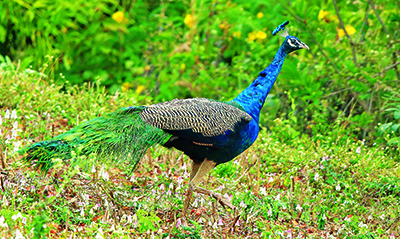 |
|
Indian Peafowl |
Raptors that specialize in either forests or open habitats are more threatened than those that are generalists. While adaptable raptors like the Oriental Honey Buzzard and the Black Kite are doing well, some groups such as harriers are in decline.
Raptors, or birds of prey, inspire awe in all of us. Some, such as falcons, are fearsome hunters and find a place in art and culture. Others live closely among us, like the Black Kite, which has adapted to feed on discarded waste, or the Peregrine Falcon, which preys on pigeons that flourish around humans. Generalist raptors, such as the Shikra and the Brahminy Kite, however, are doing well.
According to the report, several birds of interest need immediate help. The iconic Sarus Crane, which is widely believed to pair for life, has rapidly declined over the long term and continues to do so. Similarly, the Forest Wagtail’s numbers are reducing, though the causes of the decline are not understood. The Pied Kingfisher, Common Crane, Sirkeer Malkoha, Grey Wagtail and Spot-winged Starling have all shown a rapid decline in recent years.
Endemic birds seem to be declining more rapidly than others and Western Ghats endemic birds are most severely impacted, such as the White-bellied Blue Robin.
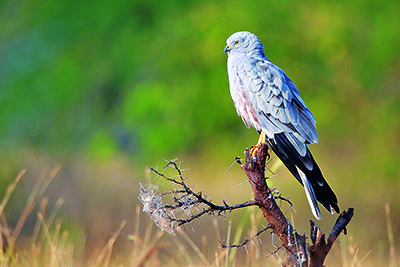 |
|
Montagu Harrier |
Climate change is a major reason pushing mountain species directly towards extinction. The report points out that the diverse terrestrial bird species is concentrated largely in tropical mountains, with each species adapted to a specific temperature range tied to altitude. The Himalayas and Western Ghats are particularly rich in bird diversity, with the latter being a hub for some unique birds. However, climate change is posing a threat to high-elevation bird species as favourable conditions shrink at mountain summits, potentially causing local extinctions.
With its loud and distinct song, the Asian Koel is part of folklore, poetry, and art in India. It is among the few birds whose song most Indians are likely to immediately recognize. The koel is known to exploit crows, laying eggs that are thought to partly resemble crow eggs. While crows accept koel chicks as their own, they are fiercely aggressive towards adult koels in the breeding season, chasing and sometimes even killing them. Asian Koels occupy a variety of habitats, wherever crows or mynas are found.
Now, for some good news! Our stunning national bird is one of the most rapidly increasing species in the country today, expanding into habitats where it has never lived previously. In the past 20 years, the Indian Peafowl has ventured into the high Himalayas and the rainforests of the Western Ghats. It’s now found in every district in Kerala, a state where it was once extremely rare.
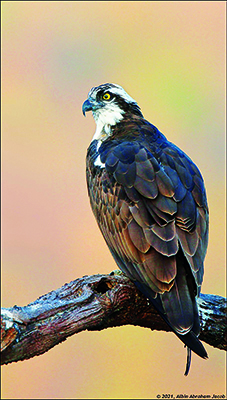 |
|
Osprey |
The good news of the increase in peafowl must be tempered by a recognition of increased reports of crop damage (and consequent retaliatory poisoning) in different parts of the country, and the speculation that rising peafowl populations may have negative impacts on snakes and other reptiles. While conservation tends to focus on rare and declining species, it is important to investigate the impacts of this peafowl boom on both people and ecosystems. The Rock Pigeon is the ultimate example of living in harmony with humans. All over the world, it has successfully adapted to live in human habitation, nest on human structures, and feed on whatever humans provide.
Habitat specialists — particularly specialists of grasslands and other open habitats, wetlands, and woodlands — are declining rapidly. In terms of diet, carnivores, insectivores, and granivores are declining more rapidly than omnivores or fruit- and nectar-eaters. Separately, migratory species appear to be under greater threat than non-migrants. And species endemic to the Western Ghats-Sri Lanka region are faring worse than others. The finding that a large number of common species are in trouble is cause for concern.
The report calls for policy and action to be aligned to highlight species of high conservation priority, address problems of neglected habitats, and promote research and monitoring to arrest such declines.
Comments
-

Madhavan Nambiar - Oct. 24, 2023, 10:22 a.m.
Very interesting and informative article - The pictures are also great
-

Dr. Narasimha Reddy Donthi - Oct. 21, 2023, 10:58 a.m.
This is the most important report that has been produced in India, on decline in biodiversity and species loss. Pesticides have been the biggest cause for this decline. We need to curb hunting of the birds, poisoning through pesticides and pollution and habitat loss.



